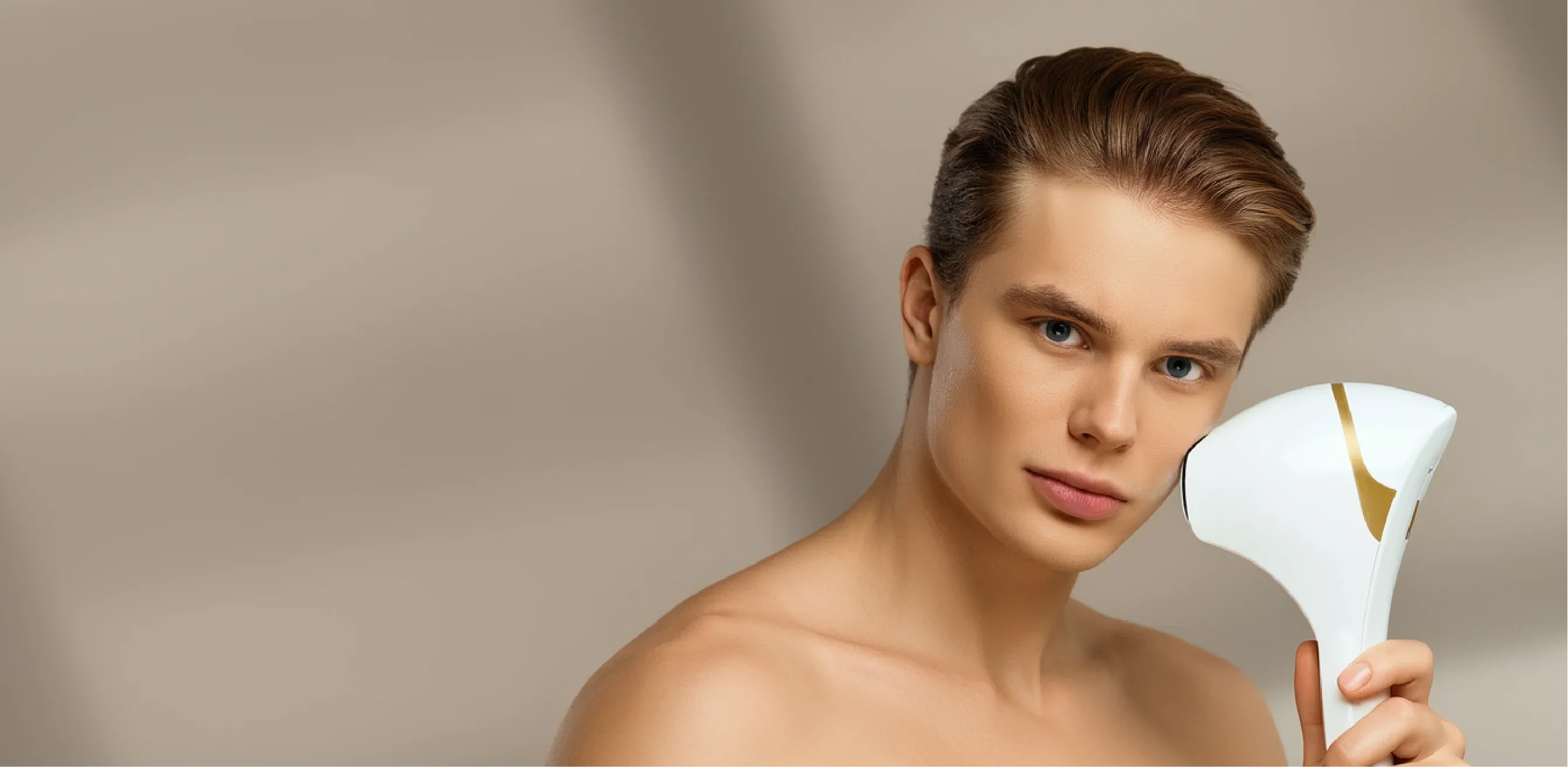by Noah Cooter
There are no end of hair removal methods out there, some better than others. One thing’s for sure, laser hair removal is the most advanced, most permanent option among all the hair removal procedures available. But that doesn’t mean we don’t have questions. Is it safe? Does it hurt? Are there side effects? In this article, we’ll unpack potential hair removal side effects, discuss the causes, and offer tips for prevention so you can achieve the safest and most effective experience possible.
Does Laser Hair Removal Hurt?
We’ve all wondered if laser hair removal hurts. In truth, the discomfort and safety of laser hair removal varies widely and depends on the device and laser type used for treatment. The intensity of sensation is relative to the intensity of energy being delivered by the device’s concentrated light beam. Overall, hair reduction with laser is generally considered a tolerable procedure, with most people reporting a pain level between 2 and 4 on a scale of 1 to 10. Let’s take a closer look at pain levels relating to specific device types.
Pain and Discomfort: In-Clinic Lasers
Licensed laser clinics have access to medical devices with stronger lasers than the ones available to the public—though not all clinics use clinical-grade devices. Many use at-home devices to remove unwanted hair. We'll cover at-home devices later. For now, let’s unpack the most common professional-grade laser types used in clinics:
Nd:YAG Lasers
The Nd:YAG laser is generally considered the most painful type of laser used for removing hair. Treatments are often described as feeling like a rubber band snapping against your skin.
Alexandrite Lasers
Alexandrite lasers also feel like a rubber band snap, though treatments are reported as less intense than with Nd:YAG lasers.
Diode Lasers
Considered the least painful medical-grade laser type, diode lasers can feel like a mild sting.
Pain and discomfort: At-Home Lasers
At home devices vary greatly in specification and type. The most common laser types available for at-home use are diode lasers and IPL devices.
IPL Devices
It’s important to note that IPLs are not true laser devices. Instead, they scatter intense pulsed light across the skin. IPL devices are described as feeling like a warm snap and are generally more painful than diode laser devices.
At-Home Diode Lasers
At-home Diode lasers use a focused wavelength to target melanin in the hair follicle, making them more precise and less painful than IPLs. In fact, when directed by the Smart Precise Optical Targeting technology in Epilaser, diode laser hair removal is so precise that for many, it doesn’t hurt at all.

Causes
Pain and discomfort during laser hair removal stems from heat generated by the laser as it targets follicles. Nerve endings at the base of the follicles can be stimulated by the heat, leading to a sensation of discomfort. The discomfort is greater if the laser energy affects a larger treatment area. Less precision equals more pain.
Treatment
Many clinicians use numbing creams to prepare for hair removal, especially for patients with a low pain threshold.
Prevention
The degree of irritation depends on how much laser energy is absorbed by the skin. A skilled clinician will minimize irritation by conducting precise treatments that don’t overexpose the skin. If you want gentle hair removal, consider Epilaser, which uses an advanced microcomputer to deliver ultra-precise at-home treatments that don’t affect skin.
Post-Treatment Side Effects: Redness and Swelling
Many people experience mild irritation, redness, and/or swelling after laser hair removal treatments. The severity of aftereffects depends on the type of device used, as well as your skin’s sensitivity.
Causes
Redness and irritation are caused by heat from the laser. This heat can cause the skin to swell, become red, and feel tender. This can be similar to the sensation after waxing or plucking. It can be more pronounced if the treatment area is overexposed to laser energy. If the treatment is conducted by a skilled clinician, these symptoms will be mild and should dissipate after a few hours.
Treatment
Redness and swelling may respond well to a cool bath and/or ice packs applied to the treated area. Professional laser hair removal clinics often treat the area with cooling gels after treatment to help reduce irritation.
Prevention
Specialty devices can be used to alleviate these symptoms altogether. Epilaser, for example, uses SPOT™ technology to hyper-target hair follicles without affecting skin at all.
Skin Discoloration
Laser hair removal devices work by heating melanin in hair follicles. Some laser devices can inadvertently heat and damage melanin in the skin, which can lead to discoloration. In some cases, permanent changes to skin tone can occur. This can manifest as either hyperpigmentation or hypopigmentation.
Cause of Hyperpigmentation
Skin sometimes responds to laser damage by producing extra melanin, thereby darkening the damaged area. This is called hyperpigmentation. People with dark and light skin can both be affected.
Cause of Hypopigmentation
If the lasers damage the melanin-producing cells (melanocytes), the effected skin can become lighter in color than the surrounding area. This is called hypopigmentation. Both light and dark skin can be affected.
Treatment
Both conditions can be temporary or permanent. Various treatments are available to alleviate discoloration of the skin. Hyperpigmentation treatment options range from topical products like hydroquinone and retinoids, to in-office procedures such as chemical peels, laser therapy, and microneedling. Hypopigmentation treatments aim to stimulate melanin production to even out skin tone. Treatment options vary depending on the cause and severity of hypopigmentation and may include medications, phototherapy, or procedures like laser therapy or skin grafting.
Prevention
It’s important to select the correct laser device for your skin color. Different skin tones respond differently to specific laser wavelengths. Dark hair and darker skin tones are better suited for 980 nanometer wavelengths, while lighter skin tones are better suited for 808 nanometer wavelengths. Epilaser 808 is calibrated for skin types 1 through 4 on the Fitzpatrick scale. Epilaser 980 laser hair removal device for dark skin is calibrated for skin types 5 and 6 on the Fitzpatrick scale. Both devices avoid damaging melanin in skin by emitting laser energy at the correct wavelength and using HD image processing to target follicles only, emitting laser energy at the correct wavelength and using HD image processing to target follicles only.
Burning and Scarring
Lasers work by emitting a concentrated beam of light that distributes heat from one place to another. In rare cases, possible laser side effects include burns from excessive heat during laser treatments. In extreme cases, this can result in permanent scaring of the tissue.
Causes
Skin burns can result from misuse of the device by an inexperienced technician, or by improper use of an at-home device. In either case, the skin is ultimately overworked by the device and is therefore overexposed to laser energy. Burns can also result from using the wrong laser wavelength on your skin.
Treatment
For severe burns, patient care should be administered by a trained physician. To reduce the risk of burning, always consult a doctor for any injury or side effects relating to laser hair removal. Treatment for burns often involves cooling the burned area with cool water or a cold compress, followed by administering pain relief medications. Avoid applying greasy or occlusive ointments unless directed by a medical professional. If the burn is severe or doesn't improve with home care, seek medical attention.
Prevention
It’s very important to seek out an experienced technician for laser treatments. If a qualified clinician is not available in your area, or if you prefer the convenience of an at-home device, consider investing in an Epilaser. The built-in SPOT™ technology targets follicles only, never skin. If no follicles are present, the lasers won’t engage. Therefore, it’s impossible to overwork or irritate your skin.
Lasers, Eyes and Vision
Laser hair removal near the eyes can pose risks to eye health if proper precautions aren't taken. Retinal and corneal burns can occur if the eyes are exposed to laser energy at wavelengths used in laser hair removal. Never use any laser hair removal device on or around the eyes.
Causes
Prolonged treatments, particularly near the eyes, can increase the risk of overheating eye shields or other protective devices, leading to injury. The intense light emitted by at-home IPL devices can damage the delicate tissues of the eye, leading to various complications.
Treatments
Injuries to the eye can be very serious and should be treated by a qualified medical professional.
Prevention
When receiving in-clinic treatments, the clinician will provide the necessary goggles or other eye protection before treatment. When using an at-home device, it’s important to carefully follow all instructions provided.
Rare Side Effects: Allergic Reactions
Some people can experience allergic reactions to the numbing creams or cooling gels used in clinical laser hair removal. Be sure to inform your clinician ahead of time of any allergies and skin sensitivities you have.
Conclusion
Permanent laser hair removal can be quite safe and effective when the correct device is used, and treatments are carried out with precision. Generally, side effects are minor and can be avoided by using the right equipment. Removing hair safely requires either a trained professional or an advanced at-home device that mitigates risk. The most common side effects are redness and irritation, which usually dissipate within twenty-four hours. People with very sensitive skin should consider using Epilaser, the only ultra-gentle laser hair removal device that targets follicles with ultra-precision, leaving skin untouched. For many, Epilaser hair removal is pain-free and safe for all skin tones, delivering finer and lighter hair in less time.






Share:
How Often Should You Do At Home Laser Hair Removal?
Does Laser Hair Removal Hurt?